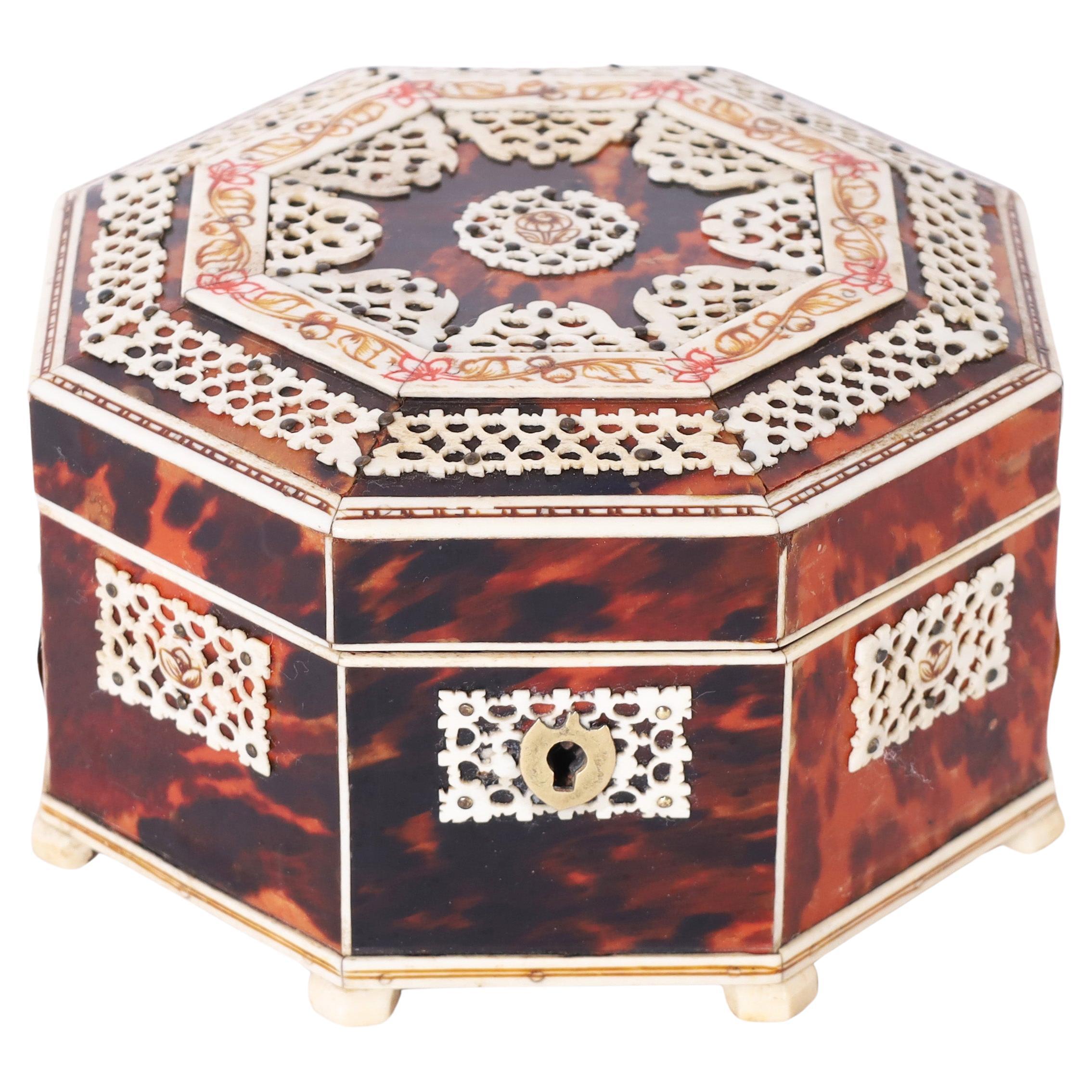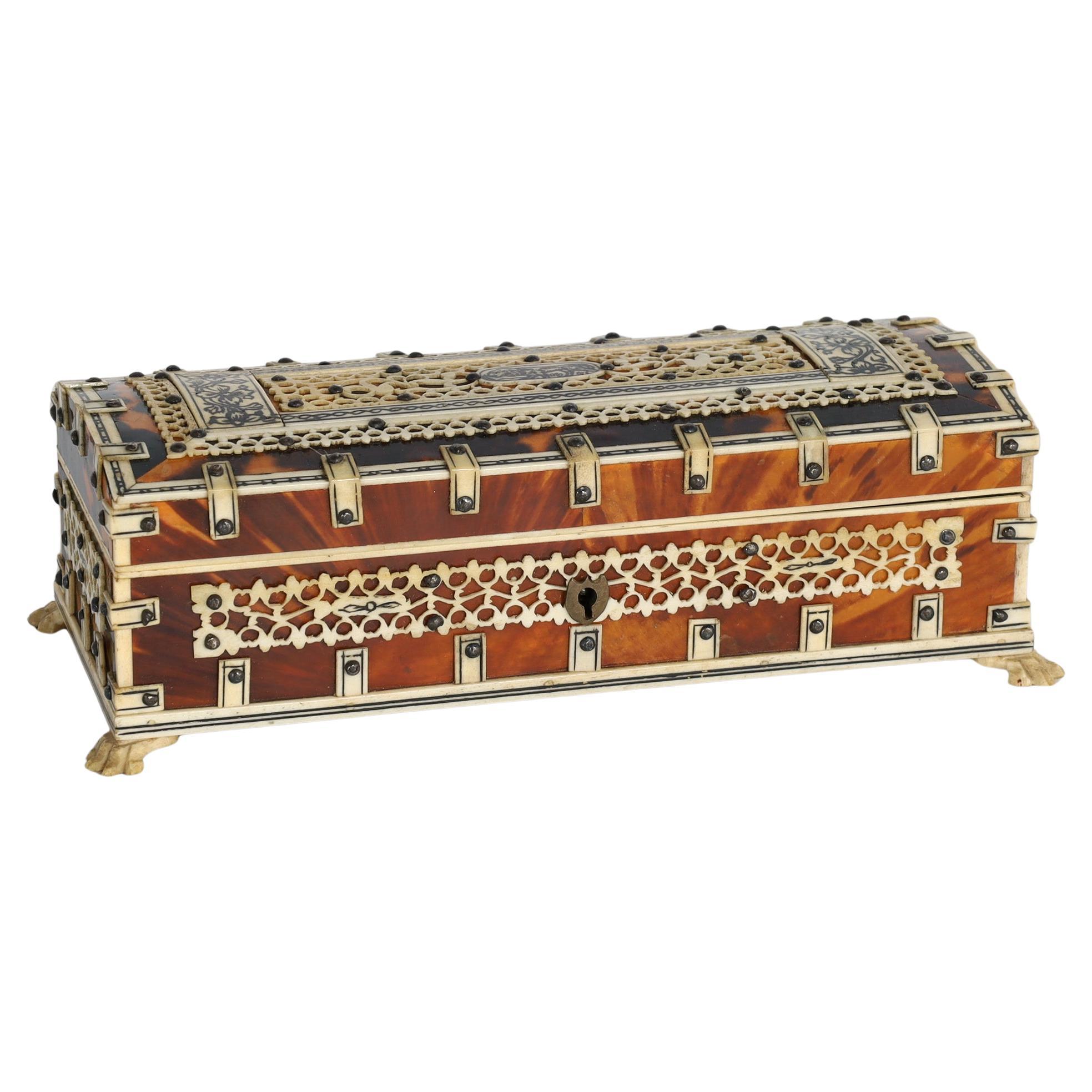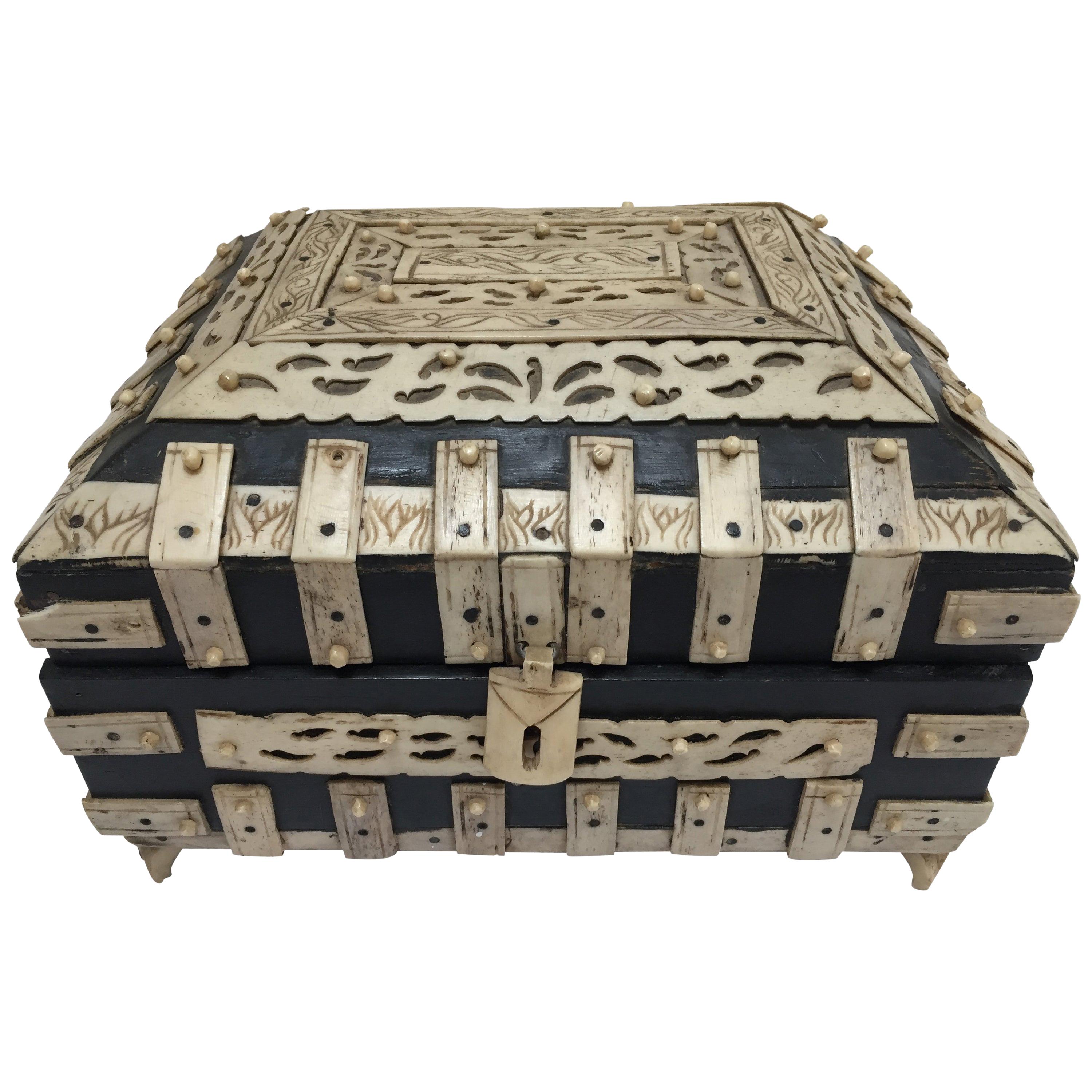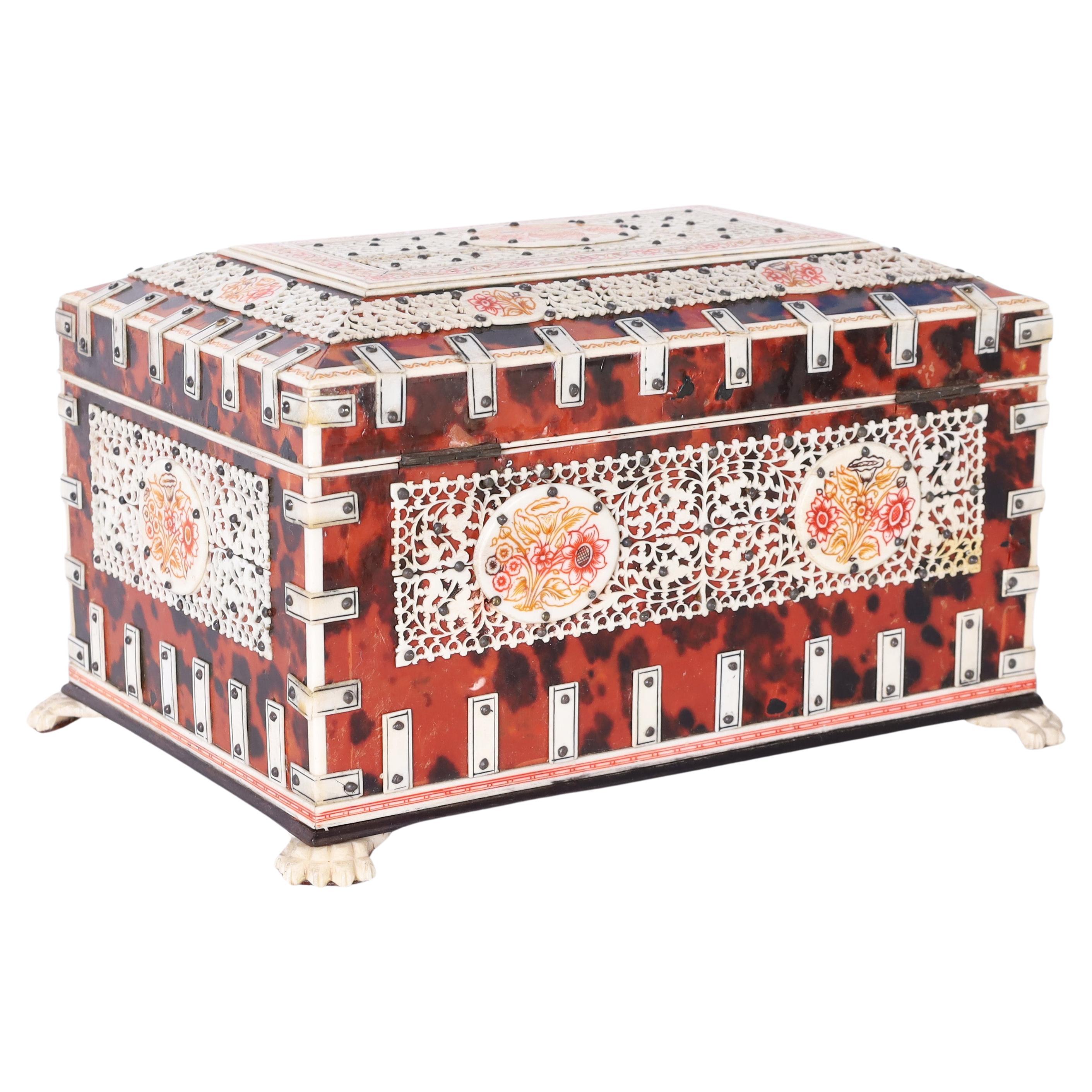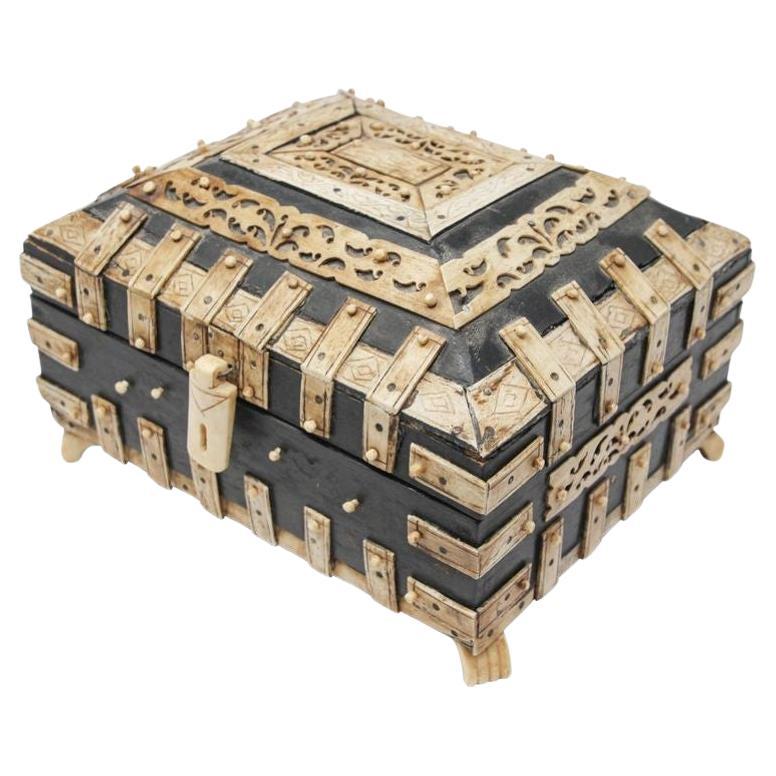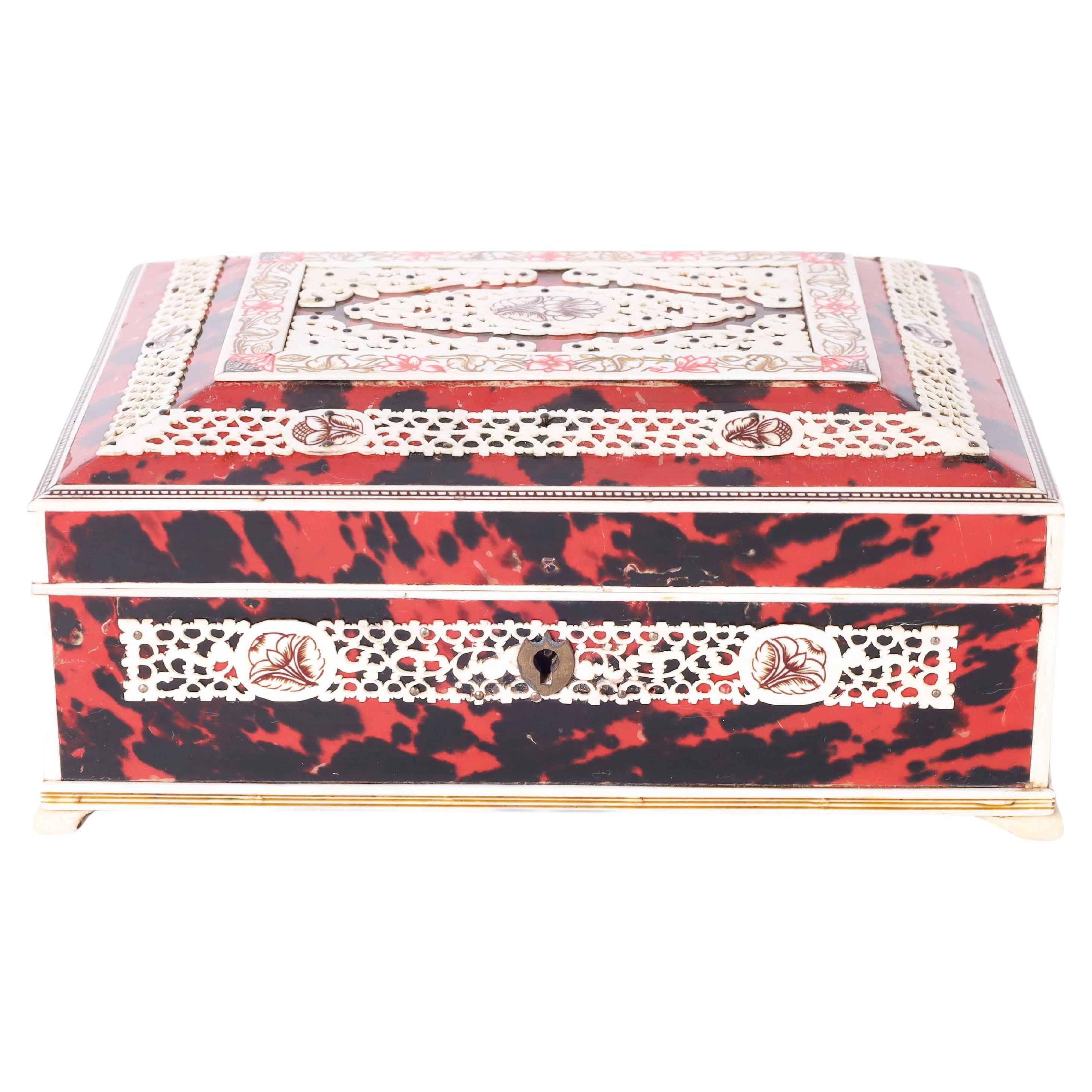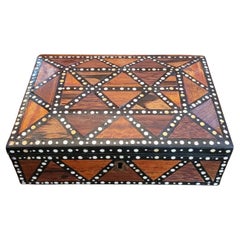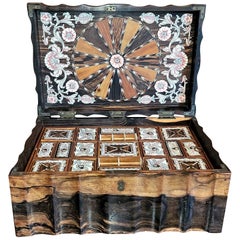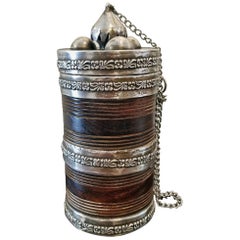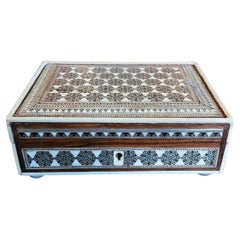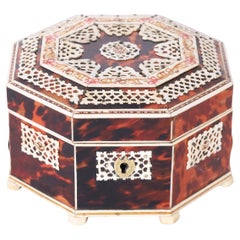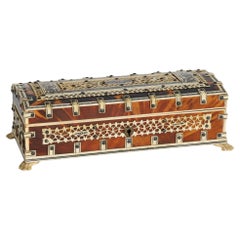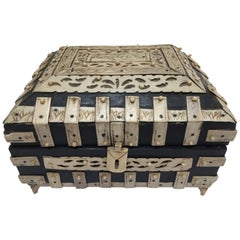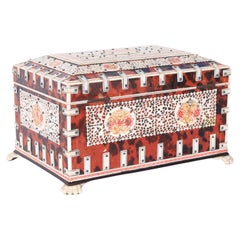Items Similar to 19C Anglo Indian Vizagapatam Bone and Shell Domed Stationery Box
Want more images or videos?
Request additional images or videos from the seller
1 of 14
19C Anglo Indian Vizagapatam Bone and Shell Domed Stationery Box
$1,300
£994.60
€1,137.48
CA$1,851.09
A$2,004.95
CHF 1,061.91
MX$24,256.88
NOK 13,349.85
SEK 12,444.90
DKK 8,495.24
About the Item
PRESENTING A LOVELY 19C Anglo Indian Vizagapatam Bone and Shell Domed Stationery Box – ‘Alice’s Box’.
Made in Vizagapatam, India, circa 1860-80.
We call this one: “Alice’s Box”! It has lived ‘a hard, well used and traveled life’, as is evident from the number of losses and repairs, as is obvious from the photos, especially to the faux ivory panels and bands to the top. The bonus to the loss of the frieze panels to the dome has a ‘bonus’, however, as their loss has revealed the most GORGEOUS faux blonde tortoiseshell underneath!
The box is dome/casket shaped.
The top has 3 bands, with the center one being the original. The 2 side bands are later ivorine.
The faux ivory and hand-painted medallions on the domed lid, have been saved and they depict Hindu Gods, Vishnu and Shiva.
The front and side panels are still in pretty good shape and are decorated with lac ink (indelible ink made from crushed beetles) depicting lovely floral designs.
The domed lid open to reveal a series of open compartments for envelopes, writing paper etc. and one lidded panel for stamps.
Inside the box are 2 paper labels: one probably being the original item ticket and the other with:
” Alice’s address is 272 Ashworth Ave, Toronto 4, Ontario”.
Probably, the original owner? Hence, we call it ‘Alice’s Box’.
What a journey/life this box has had!
Made in India, made its way to Canada, back to Ireland and then to Texas!
This is why, WE LOVE ANTIQUES!
It sits on 4 carved bone lions paw feet.
Despite its damage, it is still BEAUTIFUL!
- Dimensions:Height: 7.25 in (18.42 cm)Width: 8.5 in (21.59 cm)Depth: 5.25 in (13.34 cm)
- Style:Anglo-Indian (Of the Period)
- Materials and Techniques:
- Place of Origin:
- Period:
- Date of Manufacture:1860-80
- Condition:Repaired: See full listing. Wear consistent with age and use. Minor losses. Minor structural damages. Minor fading. Has obvious condition issues. Lost fretwork, replacement banding. But the shell is still gorgeous. If it were not for the repairs, this box would be priced at multiples of the amount here.
- Seller Location:Dallas, TX
- Reference Number:1stDibs: LU3978134902592
About the Seller
4.9
Gold Seller
Premium sellers maintaining a 4.3+ rating and 24-hour response times
Established in 2015
1stDibs seller since 2018
397 sales on 1stDibs
Typical response time: <1 hour
- ShippingRetrieving quote...Shipping from: Dallas, TX
- Return Policy
More From This Seller
View All19C Anglo Ceylonese Specimen Wood Trinket Box
Located in Dallas, TX
PRESENTING A BEAUTIFUL and RARE 19C Anglo Ceylonese Specimen Wood Trinket Box.
Made in ‘Galle’, Ceylon (now Sri Lanka) circa 1860-80.
Made for the ex...
Category
Antique 19th Century Sri Lankan Anglo-Indian Jewelry Boxes
Materials
Bone, Hardwood, Ebony, Sandalwood
19C Anglo Ceylonese Sewing Box of Museum Quality
Located in Dallas, TX
Presenting an absolutely stunning 19c Anglo Ceylonese sewing box of museum quality.
Made in Ceylon (now Sri Lanka) circa 1860, this is one of the finest sewing boxes of it’s kind that we have ever seen!
The box is made from coromandel wood (an exotic hardwood found in Ceylon) and has a serpentine edging all over the front, back and sides.
Very often the lids/tops of these boxes suffer cracks due to shrinkage but this one is near perfect with no crack in the lid/top. There is some evidence of natural shrinkage but that is around the edges of the lid/top.
It is when you open this box that it reveals it’s true beauty, quality and treasure !
The inside of the lid/top is heavily and beautifully decorated with inlaid bone in scrolling floral patterns which have then been hand painted with red and black ‘lac’ ink. The central medallion is a circle of inlaid specimen exotic hardwoods radiating towards a central bone and hand painted flower. The circle is edged in bone, wood and silver chevrons.
What makes this box Exceptionally rare is that it contains 3 lift out base sections. Normally, there would be a maximum of 2.
The first tray/section is clearly for the purposes ancillary to sewing with a pair of sections with bone spools for thread etc. There are 17 other lidded compartments with each one highly decorated using hand painted bone and specimen woods to replicate tortoiseshell.
The first tray lifts out to reveal a second removeable tray which is made up of a pair of open sections and 8 specimen wood lidded sections each with chevron banding.
The third tray is a smaller tray underneath with 14 lidded compartments each with hand painted bone and specimen wood inlaid lids again, replicating the look of tortoiseshell. Again they are banded with a chevron border.
This is a museum quality piece !
It is in fantastic condition for it’s age with the minor shrinkage to the edges of the lid/top, some finger pulls missing and some very minor cracks to the tray lids and bases but nothing that in any way detracts from the piece. No key.
Dimensions: Closed the box is 16.75 inches wide, 11.25 inches deep and 7.5 inches high
Fully open the box is 16.5 inches high, 16.75 inches wide and 11.4 inches deep
Anglo-Indian and ceylonese boxes: Anglo Indian boxes were made in India for the English residents from the early part of the 18th century. They were brought back or sent back to England usually by the people who had commissioned them. From the beginning of the nineteenth century they were imported more commercially, although not in any significant numbers until the middle decades. They were very highly valued, especially the early ones, to the extent that the designs were copied on late 19th and early 20th century tins.
Anglo-Indian boxes normally consist of 3 main types:-
(1) Most of the best and highest quality Anglo-Indian boxes in the 18th and 19th centuries were made in Vizagapatam, India, renowned for its exquisite craftsmanship in using ivory and tortoiseshell and lac decoration. These are referred to as ‘Vizagapatam Boxes...
Category
Antique Mid-19th Century Sri Lankan Anglo-Indian Decorative Boxes
Materials
Silver
19th Century Anglo-Indian Spice or Tea Caddy with Silver Mounts
Located in Dallas, TX
PRESENTING A GORGEOUS 19C Anglo Indian Rosewood Caddy with Silver Mounts.
Really nice and unusual, 19th Century Anglo-Indian Spice or Tea Caddy, from cir...
Category
Antique Late 19th Century Indian Anglo Raj Tea Caddies
Materials
Sterling Silver
19C Anglo Indian Bombay MOP Sadeli Mosaic Trinket Box
Located in Dallas, TX
PRESENTING a LOVELY 19C Anglo Indian Bombay MOP (Mother of Pearl) Sadeli Mosaic Trinket Box from circa 1875-85.
Gorgeously detailed and hand-crafted ‘sadeli mosaic’ inlay, from the Bombay Area, with deep greens with silver, pewter, mother of pearl, bone and ebony in geometric patterns.
The box case, is made of sandalwood but completely covered in MOP, bone, faux ivory, ebony and mosaic inlay.
Edged with faux ivory and banded with a different pattern of sadeli mosaic.
Some minor damage to the top (repair is obvious in pics) and ivorine replacements to some edging, but it still a BEAUTIFUL BOX and of real QUALITY!
The mosaic work is FABULOUS!
Box opens to reveal its original blue velvet lining.
It sits on 4 (recently added) silvered button feet.
SADELI MOSAIC: “Anglo Indian boxes were made in India for the English residents from the early part of the 18th century. They were brought back or sent back to England usually by the people who had commissioned them. From the beginning of the nineteenth century they were imported more commercially, although not in any significant numbers until the middle decades. They were very highly valued, especially the early ones, to the extent that the designs were copied on late 19th and early 20th century tins.
The ancient art of Sadeli Mosaic is said to have been introduced from Shiraz in Persia via Sind to Bombay, a long time before the Anglo Indian boxes were made. It was a technique, which required a high degree of skill and patience. It was executed very lavishly, in that the frequent cuts wasted a great amount of the precious materials used. The workmanship was however more than commensurable to the value of the materials.
Ivory, silver, pewter (or other metals), wood and horn were cut into faceted rods which were bound together to form geometric patterns. When the glue has set, the rods were sliced in transverse sections. This gave the maker a number of angled circular pieces in the original pattern. Several variations of patterns could be achieved by combining the materials in different ways. The ivory was sometimes dyed green to give an extra color.
The mosaic pieces in a combination of patterns, often separated by ivory, ebony, horn or silver stringing were used to veneer sandalwood boxes. In the early boxes, which date from the turn of the 18th to the 19th century, there are large panels of mosaic covering tops and sides of boxes. It took incredible skill to cover such large areas without any shakes or wavering of the pattern. The corners and joins on these boxes are impeccably matched.
The makers (reputed to be Persian) of Sadeli mosaic made in the first two decades of the 19th century displayed a total understanding of the qualities of the different materials they used. They combined substances, which can expand and contract according to atmospheric conditions with others, which are hard and unyielding. The result was a sharp definition of the lines and patterns, which made up the whole design.
On the early boxes the designs look deceptively simple. The fact is, they emerged from a culture, which had mastered geometry and understood how to generate a pattern from a set number of points. The patterns are so harmoniously combined that their incredible complexity is not immediately apparent.
The earliest Sadeli boxes...
Category
Antique Late 19th Century Indian Anglo-Indian Jewelry Boxes
Materials
Silver
19C Anglo Indian Highly Carved Sadeli Mosaic Sarcophagus Sewing Box
Located in Dallas, TX
PRESENTING A GORGEOUS 19C Anglo Indian Highly Carved Sadeli Mosaic Sarcophagus Sewing Box.
Made in Bombay, India circa 1860-80.
Box made of sandalwood with highly carved teak wood reliefs and panels on all sides.
Edged with bone and ebony veneers and glorious sadeli mosaic, made from tiny pieces of faux ivory, pewter, green semi-precious stone.
The box is in a sarcophagus form with domed lid.
The original brass carry handles are on the sides.
The interior is in great condition and consists of a removeable mirror under the lid portion, with the original red velvet lining behind it.
The base is removeable and contains a number of lidded compartments.
6 of the interior lids on the base, are each inlaid with sadeli mosaic banding. The rest are also carved and chased.
The interior is fully complete with 7 lidded faux ivory/bone, thread canisters with sadeli domes and the original bone thimble.
The box sits on 4 brass ball or bun feet with the original velvet lining on the base.
Some minor repairs and losses, but this box is fully complete. This is ‘rare’ as many of these boxes have not survived in such condition!
Included in the sale are 2 photos that were in the box (under the base tray). Interestingly, one of them is a view of downtown Nassau, New Providence (Bermuda) from the early 20C and stamped on the rear. What a ‘journey’ this piece has made! Made in India … travelled to Bermuda, probably via Britain … back to Ireland (where we bought it) …. then to Texas!
These boxes were made by superb Indian craftsmen, specifically for sale to the ruling British elite. These types of boxes, carved padouk and sandalwood, (whilst beautiful and superbly crafted) were of a lesser quality, than the more profusely and intricately mosaic inlay, tortoiseshell and ivory boxes, made for the British ‘Upper Classes’ in the areas of Bombay and Vizagapatam. These type of boxes were much more affordable back in 1880 (and indeed today) and would probably have been bought by mid-level diplomats, civil servants or visitors.
Sewing boxes (in general), were in EVERY Victorian home in Britain in the 19th Century and like other boxes etc were ‘status symbols’ of your place in society! The more ornate the box, the more ‘Upper Class’ you were!
Of it’s type, this one, is one of the very higher quality one’s, than the norm!
SADELI MOSAIC: “Anglo Indian boxes were made in India for the English residents from the early part of the 18th century. They were brought back or sent back to England usually by the people who had commissioned them. From the beginning of the nineteenth century they were imported more commercially, although not in any significant numbers until the middle decades. They were very highly valued, especially the early ones, to the extent that the designs were copied on late 19th and early 20th century tins.
The ancient art of Sadeli Mosaic is said to have been introduced from Shiraz in Persia via Sind to Bombay, a long time before the Anglo Indian boxes were made. It was a technique, which required a high degree of skill and patience. It was executed very lavishly, in that the frequent cuts wasted a great amount of the precious materials used. The workmanship was however more than commensurable to the value of the materials.
Ivory, silver, pewter (or other metals), wood and horn were cut into faceted rods which were bound together to form geometric patterns. When the glue has set, the rods were sliced in transverse sections. This gave the maker a number of angled circular pieces in the original pattern. Several variations of patterns could be achieved by combining the materials in different ways. The ivory was sometimes dyed green to give an extra color.
The mosaic pieces in a combination of patterns, often separated by ivory, ebony, horn or silver stringing were used to veneer sandalwood boxes. In the early boxes, which date from the turn of the 18th to the 19th century, there are large panels of mosaic covering tops and sides of boxes. It took incredible skill to cover such large areas without any shakes or wavering of the pattern. The corners and joins on these boxes are impeccably matched.
The makers (reputed to be Persian) of Sadeli mosaic made in the first two decades of the 19th century displayed a total understanding of the qualities of the different materials they used. They combined substances, which can expand and contract according to atmospheric conditions with others, which are hard and unyielding. The result was a sharp definition of the lines and patterns, which made up the whole design.
On the early boxes the designs look deceptively simple. The fact is, they emerged from a culture, which had mastered geometry and understood how to generate a pattern from a set number of points. The patterns are so harmoniously combined that their incredible complexity is not immediately apparent.
The earliest Sadeli boxes...
Category
Antique 19th Century Indian Anglo-Indian Decorative Boxes
Materials
Bone, Sandalwood, Teak
19C Anglo Indian Vizigapatam Stamp Box
Located in Dallas, TX
Presenting an absolutely gorgeous and very rare 19C Anglo Indian Vizigapatam stamp box.
Made in Colonial India (the Time of the Raj) circa 1860.
Prob...
Category
Antique Mid-19th Century Indian Anglo-Indian Decorative Boxes
Materials
Bone, Shell
You May Also Like
Antique Anglo Indian Bone and Tortoise Box
Located in Palm Beach, FL
Impressive antique Anglo Indian box crafted in mahogany, clad in tortoise shell, and ambitiously decorated with bone. The inside has a mirror and red felt lining.
Category
Antique 19th Century Indian Anglo-Indian Decorative Boxes
Materials
Bone, Tortoise Shell
Petite Antique Anglo Indian Bone and Tortoise Box
Located in Palm Beach, FL
Charming petite antique Anglo Indian lidded box handcrafted in indigenous hardwoods clad in tortoise shell and decorated with elaborate lacy bone designs, featuring an etched and pai...
Category
Early 20th Century Indian Anglo-Indian Decorative Boxes
Materials
Bone, Tortoise Shell
Anglo-Indian Vizagapatam Bombay Mughal Style Footed Box With Bone Overlay
Located in Moreno Valley, CA
Nice and unusual Indian Mughal style large decorative box, filigree and carved horn.
Anglo-Indian footed domed box with exceptional engraved details throughout with filigree and carved veneered bone plaques with arabesque carving.
Vizagapatam, late 19th century.
History of the Anglo-Indian Boxes
Beginning in the early part of the 18th century, Indian artisans made what came to be known as Anglo-Indian boxes for the English residents living in India, who eventually brought or sent them back to England. At the beginning of the 19th century, India began exporting these boxes commercially, although not in any significant numbers until the 1850s. People valued them so highly that manufacturers of tins copied the designs on them in the late 19th and early 20th century.
Anglo-Indian boxes fall into four groups: Rosewood or ebony boxes inlaid;
sandalwood boxes veneered; sandalwood boxes covered with Sadeli mosaic; and carved boxes often combined with Sadeli mosaic/
The first two categories came from Vizagapatam in East India while the last two came from Bombay in West India.
English traders discovered the rich woods and intricate workmanship of Indian artisans, so colonial government officials began to recognize the work of the Indian artists and craftsmen as a source for satisfying the need for furniture and boxes, which would both serve to enhance English households in India. This gave rise to the cabinetmaking workshops in Vizagapatam between Calcutta and Madras.
Craftsmen made the first boxes to be decorated with Sadeli mosaic of rosewood or ebony, incised to give further definition to the decoration, directly inlaid into the wood. The shape of the early boxes was either sloping at the front with a flatter section at the back, reminiscent of English writing slopes, or rectangular. Artisans inlaid the borders with stylized floral scrolls and the centers with a single floral motif following a circular or oval symmetrical or asymmetrical pattern. The edging was ornamental and protective, both helped protect the end grain against the weather.
Made in Vizagapatam, situated on the south east coast of India, near Madras
These exotic boxes...
Category
Antique Late 19th Century Indian Anglo Raj Decorative Boxes
Materials
Wood
Anglo Indian Tortoise and Bone Box
Located in Palm Beach, FL
Impressive Anglo Indian box crafted in mahogany and clad in tortoise shell decorated with bone straps, carved and painted floral panels, and paw feet. The inside has a mirror and bon...
Category
Early 20th Century Indian Anglo-Indian Decorative Boxes
Materials
Bone, Tortoise Shell
Antique 19th c. Decorative Anglo-Indian Overlay Footed Box with Engraved Bone
By Rajhastani
Located in Moreno Valley, CA
Nice and unusual Jewelry decorative box with filigree bone overlaid decoration.
Large Anglo-Indian footed domed box with exceptional engraved bone de...
Category
Antique Late 19th Century Indian Anglo Raj Decorative Boxes
Materials
Wood
Antique Anglo Indian Tortoise and Bone Box
Located in Palm Beach, FL
Standout exotic Anglo Indian lidded box handcrafted in mahogany and clad in tortoise shell with applied lacy bone designs inscribed and painted with flowers. The interior has a mirro...
Category
Early 20th Century Indian Anglo-Indian Decorative Boxes
Materials
Bone, Tortoise Shell, Mirror, Mahogany
